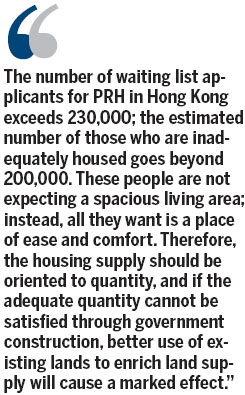Make best use of lands
Updated: 2013-10-26 06:55
By Eddy Li(HK Edition)
|
|||||||
In light of the principle of "make best use of lands", regarding the conversion of the golf driving range in Cheung Sha Wan, the HKSAR government has decided to increase public housing flats from 2,300 to 3,800, with the maximum land plot ratio raised from 6 to 7.2. The Planning Department has also extended the height limitation from 100 meters to 120 meters, enabling a flat quantity increase of 65 percent.
By modifying the scheme, the same land can accommodate 11, 600 residents, 4,600 more than the previous plan. This is undoubtedly good news for waitlisted public rental housing (PRH) applicants, because these flats are located in the urban area and should be more popular than those in the remote New Territories.
As a former member of the Town Planning Board, I have always kept a watchful eye on housing issues, and said many times in different articles and occasions that the government should relax the restriction on land plot ratio and building height as soon as possible. With a more efficient examination and approval process on new and to-be-reconstructed buildings, in a relatively short period, a considerable amount of flats would be available in the market - this is the fastest and most effective method to solve the housing shortage. And now, it is a good start that the Planning Department is willing to enhance the plot ratio and building height by 20 percent, reflecting the fact the SAR government is trying to improve the usage of lands.
The number of waiting list applicants for PRH in Hong Kong exceeds 230,000; the estimated number of those who are inadequately housed goes beyond 200,000. These people are not expecting a spacious living area; instead, all they want is a place of ease and comfort. Therefore, the housing supply should be oriented to quantity, and if the adequate quantity cannot be satisfied through government construction, better use of existing lands to enrich land supply will cause a marked effect.
Actually, the underuse of lands is attributable to the fact policies do not change with the times. For example: in Hong Kong, there are 4,011 old buildings (more than 50 years) in total, 1030 of which are categorized as buildings with obvious defects, two of which require emergency remedial works. One is the building at 51 Kai Ming Street closed not long ago by the Buildings Department. The government should consider extending the limitation of compulsory sale for redevelopment, so as to improve the redevelopment of lands.

Additionally, 1,400 industrial buildings (covering an area of 2,000 hectares) and 227 civil servants' cooperative buildings (floor area: 963,000 sq m) are potential housing resources located in urban areas - not using these for housing would be a huge waste, for the reason that they are equipped with compete and mature transport network and community facilities, and the reconstruction will be much more efficient than reclaiming wastelands. So the government should encourage reconstruction or conversion of these buildings.
Some people might challenge the legality of the project, for it gives an impression of collusion between government and businessmen. But land premium is an easy way to work the problem out. Moreover, when the building owners reconstruct their buildings, the government needn't spend any money. That saves public land resources and increases fiscal revenue, which in return, can be used in public housing supply. In short, this is a policy that benefits the public, the authorities and the companies, and is a plan not to be sneezed at.
The author is vice-president of the Chinese Manufacturers' Association of Hong Kong.

(HK Edition 10/26/2013 page1)